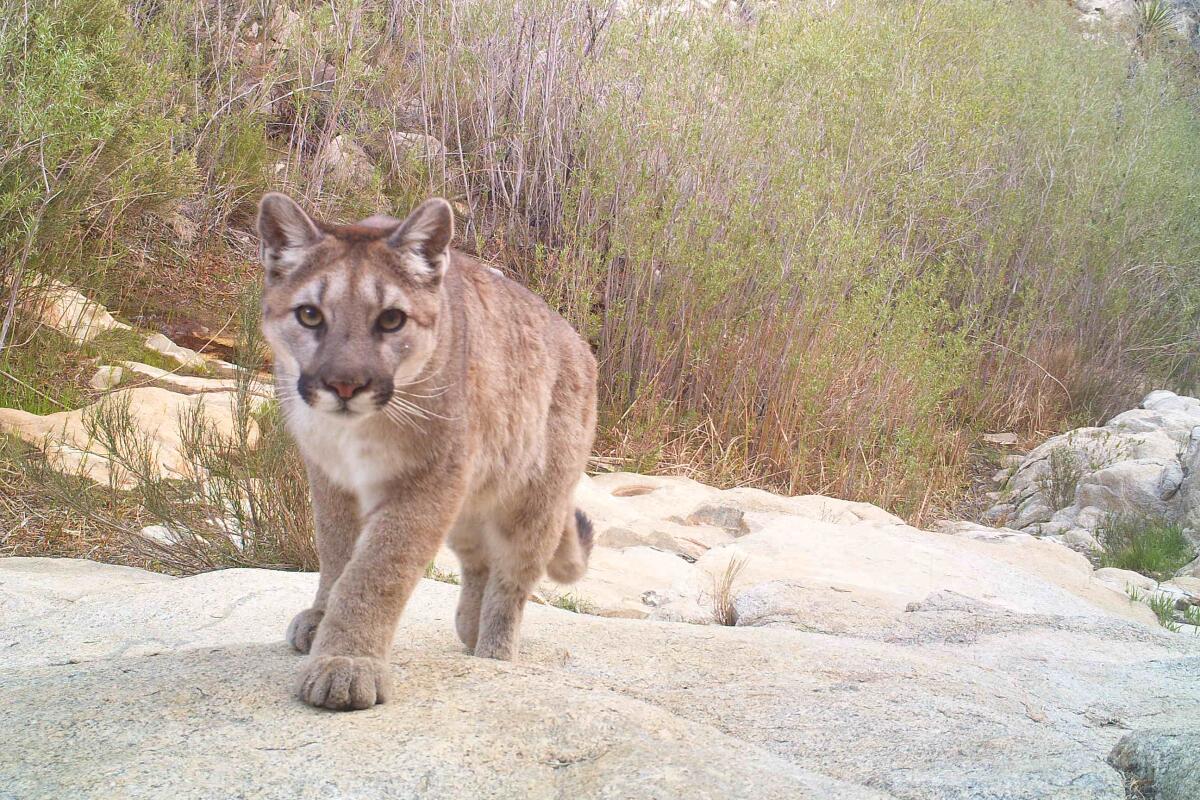A new California cougar count reveals a smaller population than previously believed

- Share via
Good morning. It’s Monday, Jan. 8. Here’s what you need to know to start your day.
- New cougar population estimates could have a big impact
- East Palo Alto went from having the highest murder rate in 1992 to zero
- 14 places Kamala Harris and Doug Emhoff like to go in L.A.
- And here’s today’s e-newspaper
Sign up for Essential California
The most important California stories and recommendations in your inbox every morning.
You may occasionally receive promotional content from the Los Angeles Times.
Why California’s new mountain lion census matters
California’s mountain lions aren’t just good subjects for magazine photos. Researchers say they play a vital role as ecosystem engineers, because their kills provide a buffet for a range of other mammals, birds and insects, which then redistribute nutrients into soil, sustaining plants and small organisms (cue the “Circle of Life” song).
So the number of the big predatory cats can have a big effect on ecosystems across the Golden State.
A new census shows there are thousands fewer mountain lions than previously thought
A first-of-its-kind cougar count puts their population in perspective.
The census, conducted over seven years by state and university scientists, estimates there are between 3,200 and 4,500 mountain lions in California. Researchers used GPS collar data and gathered genetic information from big-cat scat to model population densities in habitats across the state. They found the coastal forests of Humboldt and Mendocino counties of Northwest California have the most mountain lions, while their population is lowest in the high desert region of Inyo County.
As L.A. Times’ Louis Sahagún reported, the new estimate is notably lower than the one state wildlife officials have long used:
“The California Department of Fish and Wildlife had for decades estimated that the state’s mountain lion population was roughly 6,000 — even despite relentless vehicle strikes, wildfires and encroachment by land-hungry humans throughout their range.”
That state figure was “a back-of-the-envelope calculation without much data to support it,” Justin Dellinger, a biologist and leader of the California Mountain Lion Project, told Louis.
We’re the pumas’ biggest problem
The new research could help as state officials decide whether to grant mountain lions new protections against their biggest threat: us.
Mountain lions used to roam vast territories. Then we built into wild spaces. A sprawling freeway network now cuts them off from new areas and dissects the land into enclosed bits. Many mountain lions that try to get past all our infrastructure are killed by drivers.
“Mountain lions as a species are not listed as endangered,” Louis noted. “But in Southern California, vehicle strikes, rat poison, inbreeding, wildfires, poaching, urban encroachment and freeway systems are all contributing to what scientists call an ‘extinction vortex.’”
In Southern California, mountain lions boxed in by multiple freeways often end up inbreeding. Researchers have warned that the populations in the Santa Monica and Santa Ana Mountains could go extinct within 50 years.
Look no further than the tragic tale of beloved L.A. mountain lion P-22, who made headlines for his bold freeway crossings and solitary life in Griffith Park. In the end, he suffered the same fate as many other Southland mountain lions: struck by a car driver and ultimately euthanized due to his injuries.
The Fish and Game commission is weighing a proposal to protect them
The state Fish and Game Commission has granted mountain lions in six regions candidate status to be listed as threatened, providing some protections as the commission decides whether to officially give the big cats that designation. It will make a final decision later this year.
If that happens, the effects would be notable, as Louis explained:
- The state Department of Transportation would not be allowed to build or expand highways in core mountain lion habitat without implementing adequate measures to ensure linkages and safe passage over them.
- Large-scale residential and commercial development could be prohibited or limited in mountain lion habitats within a region covering roughly a third of the state.
Today’s top stories
Murder rates are falling
- In 1992, East Palo Alto recorded the highest murder rate in the nation. Now it’s “one of the safest places” to live.
- Killings in the U.S. are dropping at a historic rate. Will anyone notice?
Homelessness is down in L.A.
- Homelessness is down in South L.A. But nearly 13,000 remain unhoused.
- Mayor Bass, one year in: Progress on homelessness but still a steep climb.
Writing cursive is so back
- California law now requires teaching cursive in schools.
- We asked readers to show off their own cursive skills, and tell us why writing it matters (or doesn’t).
The Golden Globes refuse to die
- Here are the winners of the 2024 Golden Globes.
- Our photographers captured the best fashion from the 2024 Golden Globes.
- With a flailing Jo Koy at the helm, the Golden Globes’ party seriously fizzled.
It’s finally NFL playoff season
- Backups helped the Rams finally beat the 49ers, and it’s on to Detroit for the playoffs.
- Rams’ miracle journey back to playoffs proves they’re Super Bowl contenders.
- Fox Sports sideline reporter Pam Oliver, who has shrugged off a litany of obstacles to set a record for most NFL games called, isn’t ready to retire.
Did you feel those earthquakes?
- A magnitude 4.2 earthquake jolted Southern California Friday.
- A 4.1 shook up New Years Day too.
- Are you a never-feeler? If you’re routinely oblivious to the shaking, rattling and rolling, we want to hear from you.
More big stories
- The radio platform that owns KROQ and KRTH has filed for Chapter 11 bankruptcy.
- Dangerous winds thrashed Southern California this weekend while snow and ice threatened Interstate 5.
- Taiwanese Americans are glued to the ‘soap opera’ that is the high-stakes presidential election.
- Is Donald Trump subject to criminal charges for the Jan. 6, 2021, attack on the Capitol? We dove deep into the legal questions surrounding his immunity claim and what it means for all future presidents.
- A loud boom, a blast of icy wind and sheer terror on Alaska Airlines Flight 1282.
Get unlimited access to the Los Angeles Times. Subscribe here.
Commentary and opinions
- Anita Chabria: Tinkering with Prop. 47 won’t lower crime. Fixing San Quentin will
- Jean Guerrero: Worried about Trump returning to the White House? Here’s how to protect immigrants in your family.
- Robin Abcarian: Really, young voters? You want to teach Democrats a lesson by letting Trump back into the White House?
- Editorial board: Buckle up, California. Election season is underway.
- Editorial board: Endorsement: Imelda Padilla for Los Angeles City Council District 6.
Today’s great reads
Inside Kamala Harris and Doug Emhoff’s L.A. Even in a city full of A-listers, the vice president and the second gentleman — and the traffic jams that follow them — are hard to escape. In their first joint interview since Harris took office, the couple dish on their life in L.A.
How can we make this newsletter more useful? Send comments to essentialcalifornia@latimes.com.
For your downtime
Going out
- ☀️ 14 of Kamala Harris and Doug Emhoff’s beloved L.A. spots — including, yes, Zankou Chicken.
- 🥾 5 epic outdoor adventures that will make you feel powerful in 2024.
- 🦆 With Lunar New Year on the horizon, we went on a search for the best Peking duck in Los Angeles.
Staying in
- 📖 Inside Dean Koontz’s new thriller, plus 6 books for Lunar New Year
- 🧑🍳 Here are 5 recipes for nonalcoholic cocktails.
- ✏️ Get our free daily crossword puzzle, sudoku, word search and arcade games.
And finally ... a great photo
Show us your favorite place in California! Send us photos you have taken of spots in California that are special — natural or human-made — and tell us why they’re important to you.
Today’s great photo is from the L.A. Times photographer Robert Gauthier of Florence Pugh at the Golden Globe Awards.
Have a great day, from the Essential California team
Ryan Fonseca, reporter
Karim Doumar, head of newsletters
Check our top stories, topics and the latest articles on latimes.com.
Sign up for Essential California
The most important California stories and recommendations in your inbox every morning.
You may occasionally receive promotional content from the Los Angeles Times.











